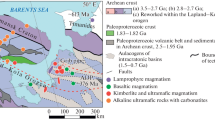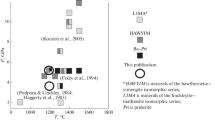Abstract
The results of experiments on the synthesis of exotic titanates (priderite and yimengite) simulating metasomatic conditions of alteration of the mantle minerals (chromite and ilmenite) are reported. Ba-free Cr-bearing priderite was synthesized for the first time. Experiments showed the possibility of crystallization of this mineral as a product of the reaction of high-Cr spinel and rutile with hydrous–carbonate fluid (melt) under the conditions of the upper mantle. In particular, the experimental data obtained provide an interpretation of the relationships between K‒Cr priderite and carbonate–silicate inclusions in chromites from garnet peridotite of the Bohemian massif. Experimental study of the reaction of chromite and ilmenite with potassic hydrous–carbonate fluid (melt) shows the presence of both titanate phases (priderite and yimengite), the mineral indicators of mantle metasomatism. This provides direct evidence for the formation of yimengite and K‒Cr priderite, as well as other titanates, due to mantle metasomatism of the upper mantle peridotite under the conditions of the highest activities of potassium.
Similar content being viewed by others
Explore related subjects
Discover the latest articles, news and stories from top researchers in related subjects.Avoid common mistakes on your manuscript.
Modal metasomatism is an important process in the upper mantle and includes the formation of phases that are not typical for peridotite and eclogite. Among them, a special place is occupied by the minerals of the crichtonite, magnetoplumbite, and hollandite groups [1]. The formation of K‒Ba titanates indicates the highest degrees of metasomatic alterations under the conditions of the high activity of potassium, which is higher than is necessary for the formation of phlogopite and K-richterite. [2]. Chromite and ilmenite are the most typical minerals of peridotite associated with K‒Ba titanates. The formation of these phases is explained by the reactions of chromite with alkali-rich fluids (melts) with a low activity of SiO2 [3]. Priderite was described as a typomorphic mineral of leucite lamproite [4]; also it is known in metasomatized peridotite xenoliths from kimberlite [3‒6], as well as inclusions in diamonds [4]. It should be noted in particular that the chromium-dominant variety of priderite is found only in metasomatized peridotite [1, 3‒6]. Yimengite is a mineral with the general formula K(Cr, Ti, Fe, Mg)12O19, the product of metasomatic alteration of chromite xenocrysts in kimberlite [7], and is observed as inclusions in diamonds in association with the minerals of the harzburgite paragenesis [8].
The stability of priderite and its Fe3+- and Fe2+-bearing varieties was studied in experiments on the synthesis of this mineral from mixtures of oxides and simple titanates at pressures of 3.5 and 5 GPa [9]. At such pressures, priderite is stable up to a temperature of ~1500°C. Experiments [10] showed that yimengite was stable at 7, 10, and 15 GPa up to temperatures of 1400‒1500°C, at which it decomposed with the formation of a number of Ti‒Cr oxides. The experimental data [9, 10] show that the stability of both priderite and yimengite in the mantle parageneses is controlled by the composition of the medium, mostly that activity of potassium, the component delivered by metasomatizing fluids and metals, rather than by the temperature and pressure. Here we report the results of the first experiments on crystallization of chromium-bearing priderite and yimengite due to the reactions of an association of chromite + ilmenite/rutile with H2O‒CO2‒K2CO3 fluid at 5 GPa and 1200°C.
Experiments were carried out on an NL-13T “anvil-with-hole” apparatus at the Korzhinsky Institute of Experimental Mineralogy, Russian Academy of Sciences (Chernogolovka). Natural chromite and synthetic TiO2 powder or natural ilmenite were applied as starting materials for the experiments. Chromite with the composition (Mg0.49–0.54Fe0.50–0.54Mn0.01–0.02Zn0.01–0.02)(Al0.17–0.20Cr1.55–1.61Fe0.10–0.22Ti0.03–0.07)O4 was collected from the xenolith of garnet lherzolite from the Pionerskaya kimberlite pipe, Yakutia. Ilmenite with the composition Fe0.98Mg0.01Mn0.06Ti0.93Al0.01Nb0.01O3 is a xenocryst from kimberlite of the Udachnaya pipe, Yakutia. The fluid component was simulated by a mixture of K2CO3 and oxalic acid. The run conditions are given in Table 1. The composition of the phases (Table 2) was analyzed by the method of X-ray spectral microanalysis on a Tescan Vega-II XMU scanning electron microscope at the Korzhinsky Institute of Experimental Mineralogyy, Russian Academy of Sciences. The Raman spectra of synthetic priderite and yimengite were obtained on a Renishaw RM1000 Raman spectrometer equipped with a Leica microscope. We used a diode-pumped solid-state laser with a radiation wavelength of 532 nm and a power of 20 mW. The spectra were registered at a 50× magnification over 100 s.
The oxygen fugacity was not buffered in our runs. However, the presence of chromite in run products allows us to estimate \(\log {{f}_{{{{{\text{O}}}_{{\text{2}}}}}}}\) on the basis of the Fe3+/Fe2+ proportion in this mineral using the equation of dependence of the deviation of oxygen fugacity for the QFM buffer (Δlog\({{f}_{{{{{\text{O}}}_{{\text{2}}}}}}}\)) on the Fe3+/Fe2+ proportion in chromite [11]. The Δlog\({{f}_{{{{{\text{O}}}_{{\text{2}}}}}}}\) values obtained indicate that the oxygen fugacity in our runs was lower than the QFM buffer by 1.1‒1.6 logarithmic units.
Potassium-bearing oxide phases were not detected in run products with chromite in the absence of Ti-bearing phases (Run Sp1, Table 1). Priderite in association with chromite and rutile appears in run products with a chromite + TiO2 mixture (Runs Sp2, A1, and A2, Table 1). Priderite forms anhedral and subhedral grains with a size up to 40 µm. There are individual grains of priderite, as well as its inclusions in rutile. In addition to priderite, run products with ilmenite (Runs B1 and B2, Table 1) contain yimengite, which also associates with chromite, ilmenite, and minor phlogopite, most likely formed due to the presence of some silicate phases (inclusions in starting ilmenite). Anhedral and subhedral grains of priderite with a size of 10‒100 µm sometimes contain chromite, ilmenite, and yimengite inclusions (Fig. 1). In addition to inclusions in priderite, yimengite forms intergrowths with chromite, similar to intergrowths known in natural associations [7].
The presence of priderite and yimengite was confirmed by Raman spectroscopy. Raman spectra of Cr-bearing priderite were obtained in the range of 150‒1200 cm–1 (Fig. 2). They contain three intense peaks at 159, 359, and 692 cm–1 (Fig. 2) close to the peaks in the spectra of natural K‒Cr priderite [3, 5]. However, the spectrum of synthetic priderite differs from the spectra of natural K‒Cr priderite by a significant shift in the major peaks towards higher wavenumbers. This most likely results from an absence of Ba in the spectrum of synthetic priderite. The Raman spectra of yimengite were obtained in the range of 250‒1200 cm–1 (Fig. 2). The spectra contain intense peaks at 378, 508, 682, and 757 cm–1, which are consistent with the spectra of synthetic solid solution hawthorneite–yimengite [10] (Fig. 2). The spectrum of yimengite obtained differs from the spectrum of the hawthorneite–yimengite solid solution [10] by a significant shift of the peaks towards the higher wavenumbers. Similarly to priderite, shift of the peaks most likely results from absence of Ba in the composition of yimengite.
Raman spectra: (I-1) K‒Cr priderite from metasomatized peridotite in kimberlite of South Africa [3]; (I-2) K‒Ba–Cr priderite from inclusions in chromite of garnet peridotite from the Bohemian massive, Czech Republic [5]; (I-3) experimentally obtained K‒Cr priderite (analysis Sp2-4, Table 2); (II-1) hawthorneite–yimengite solid solution synthesized from oxides at 12 GPa and 1400°C [10]; (II-2) experimentally synthesized yimengite (analysis B1-12, Table 2).
The composition of titanate phases in run products are reported in Table 2. The Fe (Fe2+ + Fe3+), Ti, and Cr formula units for priderite synthesized in the systems with rutile and ilmenite vary slightly (Fig. 3). The compositions of yimengite formed by the reaction of chromite and ilmenite with fluid follow the isomorphic trend (Fe2+ + Fe3+) + Ti ↔ Cr with a constant value of (Fe2+ + Fe3+)/Ti (Fig. 3). Yimengite is characterized by relatively low concentrations of Al2O3 and MgO. It contains up to 3.5 wt % Nb2O5, whereas coexisting priderite is free of this component (Table 2).
Thus, Ba-free Cr-rich priderite was synthesized in our runs for the first time. The probability of the formation of this mineral due to the reactions of high-Cr spinel associating with rutile and/or ilmenite with potassic hydrous–carbonate fluid under the conditions of the upper mantle allows us to interpret the association of Cr-rich priderite with carbonate–silicate inclusions in chromite from garnet peridotite of the Bohemian massif [5]. The proportions of Fe, Cr, and Ti in synthetic priderites are similar to the contents of these cations in natural Cr-bearing priderites from metasomatized peridotite [5, 6] (Fig. 3). This shows that the composition of Cr-bearing priderite most likely is independent of the conditions of the formation of this mineral and on its association. However, even Cr-rich priderite is not formed directly after chromite, but requires the presence of some Ti-bearing phases.
The joint crystallization of yimengite and priderite by the reaction of chromite and ilmenite with potassic hydrous–carbonate fluid at high pressures was simulated experimentally, which supports the probability of the formation of titanates due to metasomatism of upper mantle peridotite with participation of carbonate fluids or melts [3, 10] under the conditions of high activity of potassium [2]. Synthetic yimengites differ from natural ones by the higher concentrations of Ti, Fe, and Nb (Table 2, Fig. 3); this is inherited from ilmenite, after which yimengite is formed. Natural yimengites often carry evidence for the inheritance of the compositional characteristics of spinel [7]. Thus, the authors of [8] note the high concentration of TiO2 in spinel associated with yimengite and interpret this fact by the interaction of spinel with metasomatizing fluids/melts. Our runs do not simulate some other typical features of natural yimengite as well. For example, the latter is characterized by high concentrations of SiO2 (up to 1 wt %) [8], which indicates the important role of silicates in the formation of this mineral. All these data provide evidence for specific conditions of the formation of yimengite, which should be the task of further experimental studies.
REFERENCES
S. E. Haggerty, Rev. Mineral. 25, 355–416 (1991).
O. G. Safonov and V. G. Butvina, Geochem. Int. 54 (10), 858–872 (2016).
J. Konzett, R. Wirth, Ch. Hauzenberger, and M. Whitehouse, Lithos 182–183, 165–184 (2013).
A. L. Jaques, A. E. Hall, J. W. Sheraton, C. B. Smith, S.-S. Sun, R. M. Drew, C. Foudoulis, and K. Ellingsen, in Kimberlites and Related Rocks 2: Their Crust/Mantle Setting, Diamonds, and Diamond Exploration, Ed. by. A. L. Jaques, J. F’erguson, and D. H. Green (Blackwell, Melbourne, 1989), pp. 966–989.
K. Naemura, I. Shimizu, M. Svojtka, and T. Hirajima, J. Mineral. Petrol. Sci. 110, 20–28 (2015).
S. E. Haggerty, Mantle Xenoliths, Ed. by P. H. Nixon (John Wiley, Chichester, 1987).
P. H. Nixon and E. Condliffe, Mineral. Mag. 53, 305–309 (1989).
G. P. Bulanova, D. G. Muchemwa, B. J. Pearson, S. P. Griffin, S. Kelley, and C. B. Klemme, Lithos 77, 181–192 (2004).
S. Foley, H. Hofer, and G. Brey, Contrib. Mineral. Petrol. 117, 164 (1994).
J. Konzett, H. Yang, and D. J. Frost, J. Petrol. 46 (4), 749–781 (2005).
L. P. Nikitina, A. G. Goncharov, A. K. Saltykova, and M. S. Babushkina, Geochem. Int. 48 (1), 15–40 (2010).
Author information
Authors and Affiliations
Corresponding author
Additional information
Translated by A. Bobrov
Rights and permissions
About this article
Cite this article
Butvina, V.G., Vorobey, S.S., Safonov, O.G. et al. Experimental Study of the Formation of Chromium-Bearing Priderite and Yimengite as Products of Modal Mantle Metasomatism. Dokl. Earth Sc. 486, 711–715 (2019). https://doi.org/10.1134/S1028334X19060254
Received:
Published:
Issue Date:
DOI: https://doi.org/10.1134/S1028334X19060254







